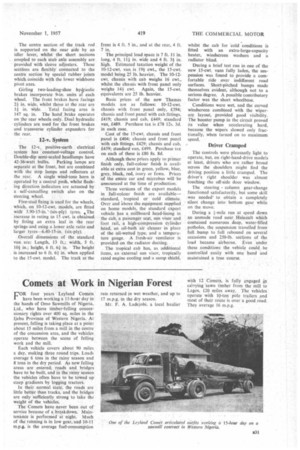Comets at Work in Nigerian Forest
Page 69

If you've noticed an error in this article please click here to report it so we can fix it.
FOR four years Leyland Comets have been working a 15-hoar day in the hands of Omo Sawmills of Nigeria, Ltd., who have timber-felling concessionary rights over 400 sq. miles in the ljebu Province of Western Nigeria. Al present, felling is taking place at a point about 15 miles from a mill in the centre of the concession area, and the vehicles operate between the scene of felling work and the mill.
Each vehicle covers about 90 miles a day, making three round trips. Loads average 6 tons in the rainy season and 8 tons in the dry period. As new felling areas are entered, roads and bridges have to be built, and in the rainy season the vehicles often have to be towed up steep gradients by logging tractors.
In their normal state, the roads are little better than tracks, and the bridges are only sufficiently strong to take tb: weight of the vehicles.
The Comets have never been out of service because of a. breakdown. Maintenatiee is performed at night. Much of the running is in low gear, and 10-11 m.p.g. is the average fuel-consumption
rate returned in wet weather, and up to 17 m.p.g. in the dry season.
Mr. F. A. Ladejobi. a local haulier with 12 Comets, is fully engaged in cirrying 'sawn timber from the mill to Lagos, 120 miles away. The vehicles operate with 10-ton pole trailers and most of their route is over a good road. They average 16 m.p.g.
























































































































